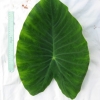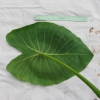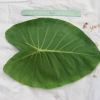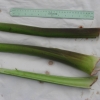Use As Food
Makes red poi of good quality. Lehua reflects the color that the poi transforms into; the fresh poi is grey and ferments into red, after a couple days.
Distribution
Grown in a few scattered localities, primarily under māla (upland) culture.
General Characteristics
Medium in height, well spreading, maturing within 8 to 12 months, producing from 5 to 10 ‘ohā; identified by pale green Hā (Petiole) with broad, purplish-black lihi (stem edges).
Ha (Petiole)
70 to 90 cm. long, pale green often tinged with reddish-brown at the top (apex), pinkish at kōhina (base) with a reddish-purple ring, the lihi (stem edge) conspicuous, broad, purplish-black with adjacent dark green blotches.
Lau or Lu'au(Leaf Blade)
40 to 55 cm. long, 35 to 45 cm. wide, 35 to 45 cm. from tip to base of sinus (māwae), broadly arrow head shaped, drooping, medium green with pinkish cast when young; margins slightly wave-like (undulate); piko pinkish; veins reddish on lower surface; round leaf section (lobes) acute with medium-cut lihi māwae (sinus).
'I'o kalo (Corm)
Flesh pale pinkish with purplish fibers; skin dark pinkish.
Pua (Flower)
Remarks
Bulletin 84 states, "This variety is repudiated to make very luxuriant growth in certain sections, rivaling the Laoloa group." This may refer to how the variety grows large.









